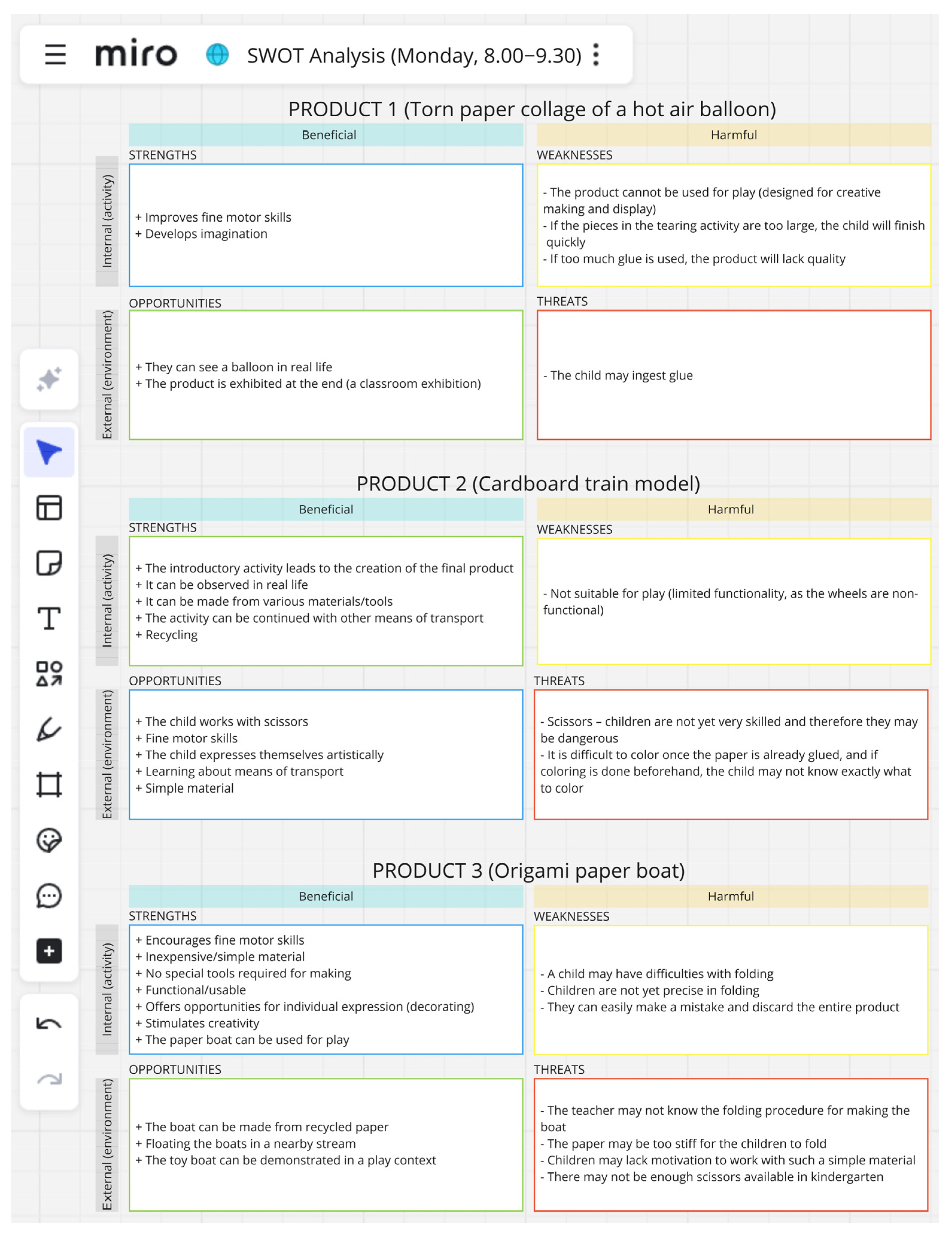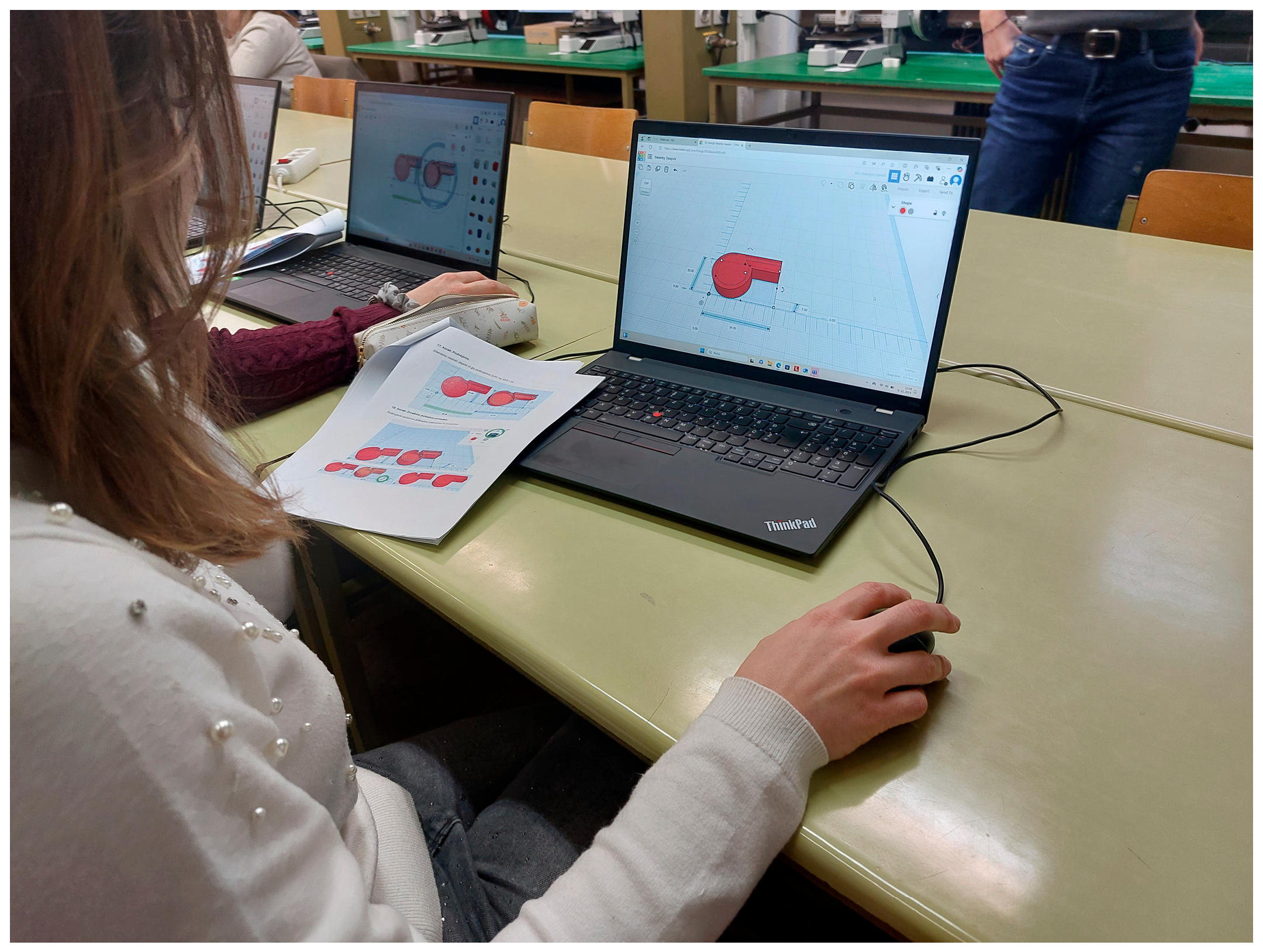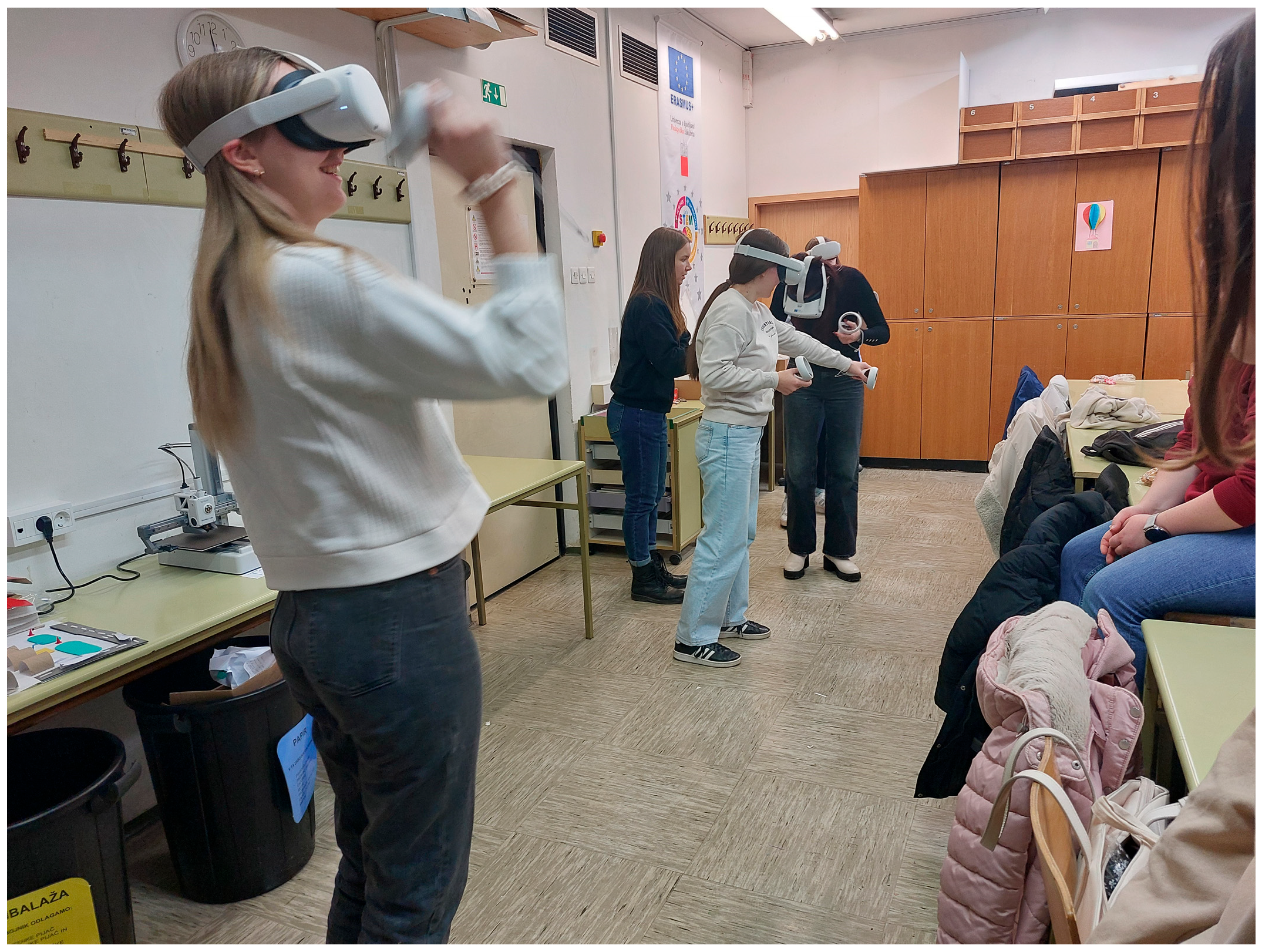Investigating How a Technology-Enhanced, Systems Thinking-Oriented Engineering Course Influences Students’ Attitudes Towards Design and Technology
Abstract
1. Introduction
2. Theoretical Backgrounds
2.1. Attitudes Towards Design and Technology
2.2. Systems Thinking Approach and Technology-Enhanced Learning Environment
3. Materials and Methods
3.1. Participants and Data Collection
3.2. Course Format
3.3. Instruments and Validation Measures
- TCA: Technological career aspirations (4 items).
- IT: Interest in technology (6 items).
- BT: Boredom with technology (4 items).
- BGD: Beliefs about gender differences (5 items).
- PCT: Perceived consequences of technology (4 items).
- PDT: Perceived difficulty of technology (4 items).
- PCOMP: Perceived ICT competence (5 items).
- PA: Perceived autonomy in ICT use (5 items).
3.4. Data Analysis
4. Results
5. Discussion
5.1. The Influences of the Technology-Enhanced, Systems Thinking-Oriented Engineering Course on Students’ Attitudes Towards Design and Technology
5.2. Limitations and Future Work
6. Conclusions
Author Contributions
Funding
Institutional Review Board Statement
Informed Consent Statement
Data Availability Statement
Acknowledgments
Conflicts of Interest
References
- Alenezi, M. (2023). Digital learning and digital institution in higher education. Education Sciences, 13(1), 88. [Google Scholar] [CrossRef]
- Ardies, J., De Maeyer, S., & Gijbels, D. (2013). Reconstructing the pupils attitude towards technology-survey. Design and Technology Education: An International Journal, 18(1), 8–19. [Google Scholar]
- Avsec, S., & Jagiełło-Kowalczyk, M. (2018). Pre-service teachers’ attitudes towards technology, engagement in active learning, and creativity as predictors of ability to innovate. International Journal of Engineering Education, 34(3), 1049–1059. [Google Scholar]
- Avsec, S., & Sajdera, J. (2019). Factors influencing pre-service preschool teachers’ engineering thinking: Model development and test. International Journal of Technology and Design Education, 29, 1105–1132. [Google Scholar] [CrossRef]
- Baptista, M., Pinho, A. S., & Alves, A. R. (2025). Students’ learning for action through inquiry-based science education on a local environmental problem. Sustainability, 17(9), 3907. [Google Scholar] [CrossRef]
- Blundell, C. N., Mukherjee, M., & Nykvist, S. (2022). A scoping review of the application of the SAMR model in research. Computers and Education Open, 3, 100093. [Google Scholar] [CrossRef]
- Cabrera, D. (2006). Systems thinking [Doctoral dissertation, Cornell University]. Available online: https://ecommons.cornell.edu/server/api/core/bitstreams/cf21d0ca-48de-4540-8914-4629f975bdcd/content (accessed on 22 April 2025).
- Cabrera, D., & Cabrera, L. (2022). DSRP theory: A primer. Systems, 10(2), 26. [Google Scholar] [CrossRef]
- Cedefop. (2023). Skills forecast 2023: Slovenia. Available online: https://www.cedefop.europa.eu/en/country-reports/slovenia-2023-skills-forecast (accessed on 25 March 2025).
- Cohen, J., Cohen, P., West, S. G., & Aiken, L. S. (2013). Applied multiple regression/correlation analysis for the behavioral sciences (3rd ed.). Routledge. [Google Scholar] [CrossRef]
- Curriculum for Kindergarten. (2025). Ministry of education, national institute of education of the Republic of Slovenia. Available online: https://www.gov.si/assets/ministrstva/MVI/Dokumenti/Sektor-za-predsolsko-vzgojo/Dokumenti-smernice/KURIKULUM-ZA-VRTCE-2025.pdf (accessed on 9 May 2025).
- Feriver, Ş., Olgan, R., Teksöz, G., & Barth, M. (2019). Systems thinking skills of preschool children in early childhood education contexts from Turkey and Germany. Sustainability, 11(5), 1478. [Google Scholar] [CrossRef]
- Gero, A. (2024). A course on contemporary issues in engineering education: Students’ attitudes. Global Journal of Engineering Education, 26(3), 182–186. [Google Scholar]
- Gu, J., Xu, M., & Hong, J. (2019). Development and validation of a technological literacy survey. International Journal of Science and Mathematics Education, 17(1), 109–124. [Google Scholar] [CrossRef]
- Guo, Z., & Fryer, L. K. (2025). What really elicits learners’ situational interest in learning activities: A scoping review of six most commonly researched types of situational interest sources in educational settings. Current Psychology, 44, 587–601. [Google Scholar] [CrossRef]
- Guzik, A., Tomczak, M. T., & Gawrycka, M. (2024). What is the future of digital education in the higher education sector? An overview of trends with example applications at Gdańsk Tech, Poland. Global Journal of Engineering Education, 26(2), 95–100. [Google Scholar]
- Hedlund, A. (2021). Beliefs and attitudes that influence learning. GiLE Journal of Skills Development, 1(2), 44–57. [Google Scholar] [CrossRef]
- Henrie, C. R., Halverson, L. R., & Graham, C. R. (2015). Measuring student engagement in technology-mediated learning: A review. Computers & Education, 90, 36–53. [Google Scholar] [CrossRef]
- Hu, X., Fang, Y., & Liang, Y. (2024). Roles and effect of digital technology on young children’s STEM education: A scoping review of empirical studies. Education Sciences, 14(4), 357. [Google Scholar] [CrossRef]
- ITEEA. (2020). Standards for technological and engineering literacy: Defining the role of technology and engineering in STEM education (STEL). Available online: https://www.iteea.org/stel (accessed on 5 May 2025).
- Kunina-Habenicht, O., & Goldhammer, F. (2020). ICT Engagement: A new construct and its assessment in PISA 2015. Large-Scale Assessments in Education, 8(6). [Google Scholar] [CrossRef]
- Kurent, B., & Avsec, S. (2023). Systems thinking skills and the ICT self-concept in preschool teachers for sustainable curriculum transformation. Sustainability, 15(20), 15131. [Google Scholar] [CrossRef]
- Ma, Y., & Qin, X. (2021). Measurement invariance of information, communication and technology (ICT) engagement and its relationship with student academic literacy: Evidence from PISA 2018. Studies in Educational Evaluation, 68, 100982. [Google Scholar] [CrossRef]
- Nikolopoulou, K., & Gialamas, V. (2015). ICT and play in preschool: Early childhood teachers’ beliefs and confidence. International Journal of Early Years Education, 23(4), 409–425. [Google Scholar] [CrossRef]
- Puentedura, R. R. (n.d.). SAMR—A research perspective. Hippasus. Available online: https://hippasus.com/rrpweblog/archives/2020/01/SAMR_AResearchPerspective.pdf (accessed on 2 June 2025).
- Radiamoda, A.-F. A. R., Ngo, C. G., Budadong, D., & Obiena, C. M. (2024). ICT engagement and digital competence of preservice english teachers. International Journal Corner of Educational Research, 3(1), 54–64. [Google Scholar] [CrossRef]
- Rihtaršič, D., & Kocijančič, S. (2012). The role of equipment and accessories in the early teaching of robotics. World Transactions on Engineering and Technology Education, 10(1), 29–34. [Google Scholar]
- Routray, S. K., & Mohanty, S. (2024). Information and communications technology for a sustainable world [Climate Change]. IEEE Potentials, 43(2), 6–12. [Google Scholar] [CrossRef]
- Stockless, A., Villeneuve, S., Bisaillon, J., Fournier, F., & Venant, F. (2022). Pre-service teachers’ competence and pedagogical use of ICT: Are they ready to develop collaborative activities with students? Computers in the Schools, 39(3), 203–229. [Google Scholar] [CrossRef]
- Svenningsson, J., Höst, G., Hultén, M., & Hallström, J. (2022). Students’ attitudes toward technology: Exploring the relationship among affective, cognitive and behavioral components of the attitude construct. International Journal of Technology and Design Education 32, 1531–1551. [Google Scholar] [CrossRef]
- Tabachnick, B. G., & Fidell, L. S. (2013). Using multivariate statistics (6th ed.). Pearson Education. [Google Scholar]
- Trapero-González, I., Romero-Rodríguez, J. M., Fernández-Martín, F. D., & Alonso-García, S. (2025). Educational robotics and STEM competence in early childhood education: Systematic review and meta-analysis of programmes and outcomes. Knowledge Management & E-Learning, 17(1), 71–87. [Google Scholar] [CrossRef]
- Tzeng, S.-Y., Yu, K.-C., Wu, P.-H., & Fan, S.-C. (2025). Do attitudes matter? An investigation into students’ attitudes toward engineering and learning performances through engineering-focused STEM curricula. International Journal of Technology and Design Education, 35, 123–150. [Google Scholar] [CrossRef]
- University of Ljubljana. (2022a). Project: Developing the twenty-first-century skills needed for sustainable development and quality education in the era of rapid technology-enhanced changes in the economic, social and natural environment (grant no. J5-4573). Available online: https://www.pef.uni-lj.si/razvijanje_vescin_21_stoletja/ (accessed on 20 May 2025).
- University of Ljubljana. (2022b). Project: ULTRA 5.02-1554 improving digital skills and competences of (future) educators for quality educational work with younger children. Available online: https://www.pef.uni-lj.si/vkljucevanje-didakticne-uporabe-ikt-pv/ (accessed on 20 May 2025).
- University of Ljubljana. (2024). Program: Strategies for education for sustainable development applying innovative student-centred educational approaches (ID: P5-0451). Available online: https://www.pef.uni-lj.si/raziskovanje-in-umetnost/projekti/ (accessed on 23 May 2025).
- University of Ljubljana, Faculty of Education. (2024). Technology education curriculum for preschool education students [Internal curriculum]. University of Ljubljana. [Google Scholar]
- Vidal-Esteve, M. I., & Martín-Gómez, S. (2023). Digitalization of Classrooms: A Comparative Study on Teachers’ Perceptions about the Use of Digital Teaching Materials in Early Childhood and Primary Education. Education Sciences, 13(11), 1156. [Google Scholar] [CrossRef]
- Vuorio, E., Pernaa, J., & Aksela, M. (2025). Pedagogical Model for teaching systems thinking in a sustainable chemistry course: A design-based research approach. Journal of Chemical Education, 102(9), 3878–3892. [Google Scholar] [CrossRef]
- Xu, M., Williams, P. J., Gu, J., Liu, M., & Hong, J. (2022). Technology teachers’ professional attitudes towards technology: An investigation of Chinese high school general technology teachers. International Journal of Technology and Design Education, 32, 2111–2127. [Google Scholar] [CrossRef]
- York, S., Lavi, R., Dori, Y. J., & Orgill, M. (2019). Applications of systems thinking in STEM education. Journal of Chemical Education, 96(12), 2742–2751. [Google Scholar] [CrossRef]
- Zhang, X., Chen, Y., Hu, L., Hwang, G. J., & Tu, Y. F. (2025). Developing preschool children’s computational thinking and executive functions: Unplugged vs. robot programming activities. International Journal of STEM Education, 12, 10. [Google Scholar] [CrossRef]




| Ks | Cs | Ls | Laboratory Work | Control Group | Experimental Group | SAMR Model | |
|---|---|---|---|---|---|---|---|
| Traditional Approach | Systems Thinking (DSRP Theory) | ||||||
| October | Introductory meeting | Providing basic information, discussing safety when working with tools, equipment, machines, etc., and production of a simple motivational product (hologram pyramid). | |||||
| Paper materials | Making paper helicopter, measuring time, calculating average from the data, and drawing graphs by hand on paper. | Making a paper helicopter, measuring time, using computers to calculate the average from the data, drawing a graph (Excel), and saving the file in the cloud (One Drive). | S, A | ||||
| Technical drawing | Technical drawing by hand and suitable tools (ruler, compasses, etc.). | Technical drawing using professional software (Solid Edge 2023). | S, A | ||||
| Decision making | Decision making on cardboard packaging in groups without any digital tools, applications, etc. | Decision making on cardboard packaging using collaborative digital environment (Miro). | S, A, M | ||||
| November | Linkage mechanism (paper materials) | Making a toy from cardboard and split pins with a linkage mechanism. Instructions, without simulation of movement. | Making a toy from cardboard and split pins with a linkage mechanism. Simulation of linkage mechanism movement in software (Linkage 3.10.11). Conceptual map. | S, A | |||
| Animation | Making an animation (Zoetrope) from cardboard and paper. | Using a mobile app (Stop motion studio), plasticine, and paper for animation production. Flowchart. | S, A, M | ||||
| Crank mechanism (combination of materials) | Making a toy from a combination of materials and mechanisms. | Making a toy from a combination of materials and mechanisms. DSRP diagram. Flowchart. | |||||
| Packaging waste (plastic bottle) | Production of a movable toy from packaging waste. | Production of a movable toy from packaging waste. Flowchart, conceptual map. | |||||
| December | Early programming | Making a game-like gadget for early programming out of paper and cardboard. | Using robot sets (Cubetto) to design early programming activities. | S, A, M, R | |||
| Modelling | Modelling a whistle from polymer clay (FIMO) and baking. | Fabricating a 3D model of a whistle using software to 3D model (Tinkercad web app) and 3D print (Bambu Studio 1.10.0). | S, A, M, R | ||||
| Woodworking | Making a puzzle—Tangram from wood in the workshop. | Making a puzzle—Tangram from wood in the workshop. Iceberg model. | |||||
| Construction | Using a construction set (Lego technic) to construct a bridge. | Using virtual reality (Meta Quest 2) to construct a bridge. | S, A, M, R | ||||
| January | Final product | Production and manufacturing of the product according to a drawn photo of the product suitable for kindergarten. | |||||
| Work report on a final product | Writing a work report on an already manufactured product based on a photo. | ||||||
| Scales of Attitudes | Experimental Group | Control Group | Reliability Measure | |||||||
|---|---|---|---|---|---|---|---|---|---|---|
| Pre-Test | Post-Test | Pre-Test | Post-Test | Pre-Test | Post-Test | |||||
| M | SD | M | SD | M | SD | M | SD | Cronbach’s α | Cronbach’s α | |
| TCA | 1.37 | 0.54 | 1.55 | 0.91 | 1.41 | 0.79 | 1.72 | 0.84 | 0.83 | 0.88 |
| IT | 1.98 | 0.57 | 2.15 | 0.75 | 2.04 | 0.60 | 2.50 | 0.79 | 0.80 | 0.80 |
| BT | 1.01 | 0.78 | 1.08 | 0.81 | 1.19 | 0.80 | 1.11 | 0.75 | 0.90 | 0.85 |
| BGD | 1.37 | 0.81 | 1.38 | 0.75 | 1.32 | 0.91 | 1.36 | 0.84 | 0.88 | 0.83 |
| PCT | 2.92 | 0.55 | 3.14 | 0.68 | 2.89 | 0.62 | 3.35 | 0.56 | 0.81 | 0.90 |
| PDT | 2.03 | 0.65 | 1.88 | 0.57 | 2.23 | 0.65 | 2.52 | 0.59 | 0.80 | 0.82 |
| Scales of Engagement | Experimental Group | Control Group | Reliability Measure | ||
|---|---|---|---|---|---|
| M | SD | M | SD | Cronbach α | |
| PCOMP | 3.23 | 0.86 | 3.60 | 0.67 | 0.89 |
| PA | 3.37 | 0.83 | 3.50 | 0.72 | 0.86 |
| Scales of Attitudes | Systems Thinking | PCOMP | PA | |||
|---|---|---|---|---|---|---|
| p-Value | Partial η2 | p-Value | Partial η2 | p-Value | Partial η2 | |
| TCA | 0.980 | 0.00 | 0.945 | 0.00 | 0.023 | 0.12 |
| IT | 0.840 | 0.01 | 0.191 | 0.04 | 0.002 | 0.22 |
| BT | 0.218 | 0.04 | 0.667 | 0.01 | 0.017 | 0.13 |
| BGD | 0.945 | 0.00 | 0.129 | 0.06 | 0.006 | 0.18 |
| PCT | 0.953 | 0.00 | 0.839 | 0.01 | 0.012 | 0.15 |
| PDT | 0.003 | 0.22 | 0.009 | 0.16 | 0.187 | 0.04 |
Disclaimer/Publisher’s Note: The statements, opinions and data contained in all publications are solely those of the individual author(s) and contributor(s) and not of MDPI and/or the editor(s). MDPI and/or the editor(s) disclaim responsibility for any injury to people or property resulting from any ideas, methods, instructions or products referred to in the content. |
© 2025 by the authors. Licensee MDPI, Basel, Switzerland. This article is an open access article distributed under the terms and conditions of the Creative Commons Attribution (CC BY) license (https://creativecommons.org/licenses/by/4.0/).
Share and Cite
Kurent, B.; Avsec, S. Investigating How a Technology-Enhanced, Systems Thinking-Oriented Engineering Course Influences Students’ Attitudes Towards Design and Technology. Educ. Sci. 2025, 15, 1256. https://doi.org/10.3390/educsci15091256
Kurent B, Avsec S. Investigating How a Technology-Enhanced, Systems Thinking-Oriented Engineering Course Influences Students’ Attitudes Towards Design and Technology. Education Sciences. 2025; 15(9):1256. https://doi.org/10.3390/educsci15091256
Chicago/Turabian StyleKurent, Brina, and Stanislav Avsec. 2025. "Investigating How a Technology-Enhanced, Systems Thinking-Oriented Engineering Course Influences Students’ Attitudes Towards Design and Technology" Education Sciences 15, no. 9: 1256. https://doi.org/10.3390/educsci15091256
APA StyleKurent, B., & Avsec, S. (2025). Investigating How a Technology-Enhanced, Systems Thinking-Oriented Engineering Course Influences Students’ Attitudes Towards Design and Technology. Education Sciences, 15(9), 1256. https://doi.org/10.3390/educsci15091256







